ORGANISATIONAL CULTURE 1
- 格式:ppt
- 大小:542.50 KB
- 文档页数:22
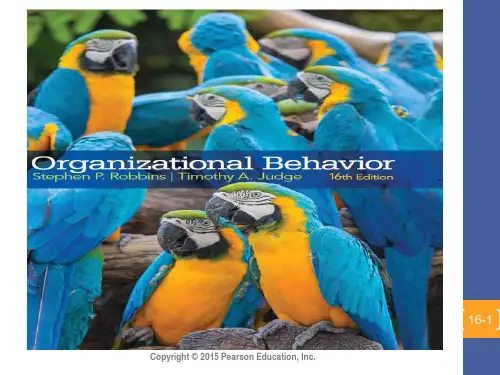
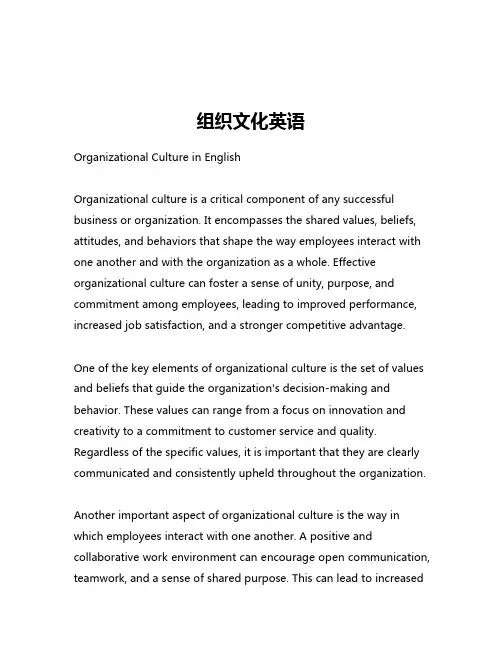
组织文化英语Organizational Culture in EnglishOrganizational culture is a critical component of any successful business or organization. It encompasses the shared values, beliefs, attitudes, and behaviors that shape the way employees interact with one another and with the organization as a whole. Effective organizational culture can foster a sense of unity, purpose, and commitment among employees, leading to improved performance, increased job satisfaction, and a stronger competitive advantage.One of the key elements of organizational culture is the set of values and beliefs that guide the organization's decision-making and behavior. These values can range from a focus on innovation and creativity to a commitment to customer service and quality. Regardless of the specific values, it is important that they are clearly communicated and consistently upheld throughout the organization.Another important aspect of organizational culture is the way in which employees interact with one another. A positive and collaborative work environment can encourage open communication, teamwork, and a sense of shared purpose. This can lead to increasedproductivity, as employees feel empowered to contribute their ideas and work together to solve problems.In contrast, a negative or dysfunctional organizational culture can have a detrimental impact on employee morale, engagement, and overall performance. Factors such as poor communication, lack of trust, and a focus on individual rather than team success can create a toxic work environment that stifles innovation and creativity.To build a strong and positive organizational culture, leaders must be intentional in their approach. This may involve developing a clear vision and mission for the organization, establishing a set of core values, and creating opportunities for employees to engage in team-building activities and professional development.One effective strategy for building a positive organizational culture is to focus on employee engagement. This can involve providing employees with opportunities for growth and development, recognizing and rewarding their contributions, and fostering a sense of belonging and community within the organization.Another important aspect of organizational culture is the way in which the organization communicates with its employees. Effective communication can help to build trust, foster a sense of transparency, and ensure that employees understand the organization's goals andpriorities.In addition to internal communication, it is also important for organizations to consider their external communication and how they are perceived by the broader community. A strong and positive organizational culture can help to build a positive brand image and reputation, which can be a valuable asset in attracting and retaining top talent.Overall, organizational culture is a complex and multifaceted concept that plays a critical role in the success and sustainability of any organization. By focusing on the development of a positive and collaborative work environment, organizations can build a strong and resilient culture that supports innovation, productivity, and long-term success.。
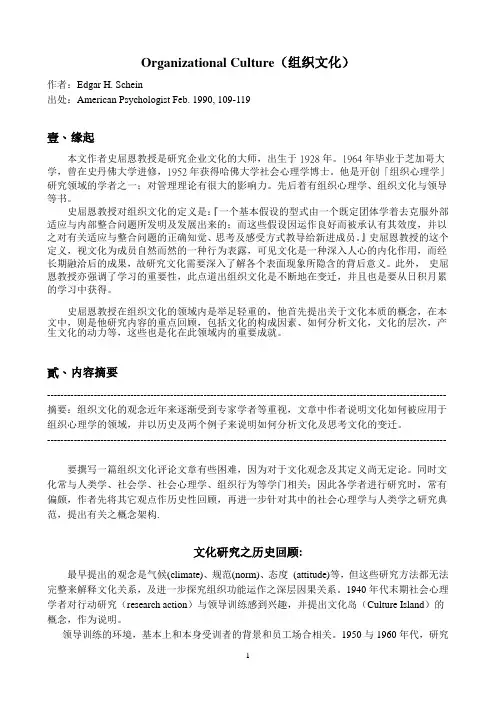
Organizational Culture(组织文化)作者:Edgar H. Schein出处:American Psychologist Feb. 1990, 109-119壹、缘起本文作者史屈恩教授是研究企业文化的大师,出生于1928年。
1964年毕业于芝加哥大学,曾在史丹佛大学进修,1952年获得哈佛大学社会心理学博士。
他是开创「组织心理学」研究领域的学者之一;对管理理论有很大的影响力。
先后着有组织心理学、组织文化与领导等书。
史屈恩教授对组织文化的定义是:『一个基本假设的型式由一个既定团体学着去克服外部适应与内部整合问题所发明及发展出来的;而这些假设因运作良好而被承认有其效度,并以之对有关适应与整合问题的正确知觉、思考及感受方式教导给新进成员。
』史屈恩教授的这个定义,视文化为成员自然而然的一种行为表露,可见文化是一种深入人心的内化作用,而经长期融洽后的成果,故研究文化需要深入了解各个表面现象所隐含的背后意义。
此外,史屈恩教授亦强调了学习的重要性,此点道出组织文化是不断地在变迁,并且也是要从日积月累的学习中获得。
史屈恩教授在组织文化的领域内是举足轻重的,他首先提出关于文化本质的概念,在本文中,则是他研究内容的重点回顾,包括文化的构成因素、如何分析文化,文化的层次,产生文化的动力等,这些也是化在此领域内的重要成就。
貳、内容摘要------------------------------------------------------------------------------------------------------------------------ 摘要:组织文化的观念近年来逐渐受到专家学者等重视,文章中作者说明文化如何被应用于组织心理学的领域,并以历史及两个例子来说明如何分析文化及思考文化的变迁。
------------------------------------------------------------------------------------------------------------------------要撰写一篇组织文化评论文章有些困难,因为对于文化观念及其定义尚无定论。
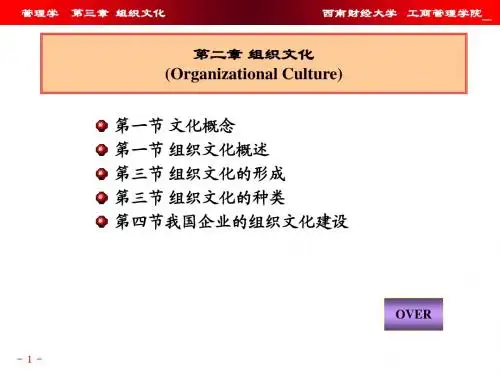
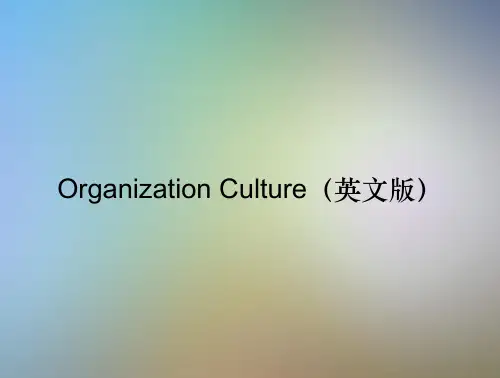
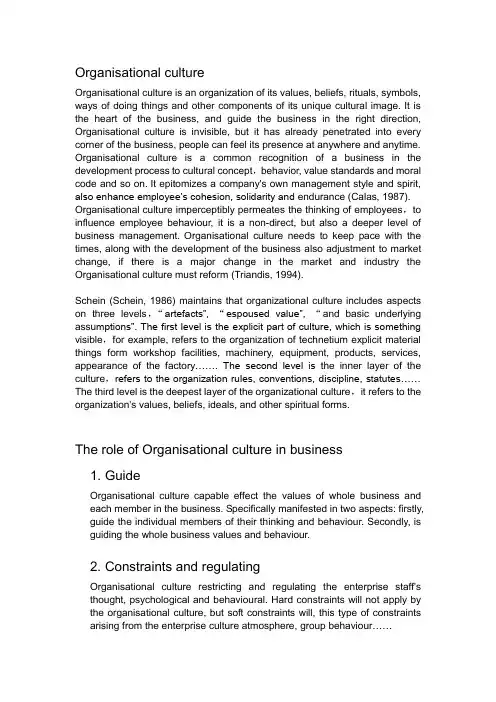
Organisational cultureOrganisational culture is an organization of its values, beliefs, rituals, symbols, ways of doing things and other components of its unique cultural image. It is the heart of the business, and guide the business in the right direction, Organisational culture is invisible, but it has already penetrated into every corner of the business, people can feel its presence at anywhere and anytime. Organisational culture is a common recognition of a business in the development process to cultural concept,behavior, value standards and moral code and so on.It epitomizes a company's own management style and spirit, also enhance employee’s cohesion, solidarity and endurance (Calas, 1987). Organisational culture imperceptibly permeates the thinking of employees,to influence employee behaviour, it is a non-direct, but also a deeper level of business anisational culture needs to keep pace with the times, along with the development of the business also adjustment to market change, if there is a major change in the market and industry the Organisational culture must reform (Triandis, 1994).Schein (Schein, 1986) maintains that organizational culture includes aspects on three levels,“artefacts”, “espoused value”, “and basic underlying assu mptions”. The first level is the explicit part of culture, which is something visible,for example, refers to the organization of technetium explicit material things form workshop facilities, machinery, equipment, products, services, appearance of the facto ry……. The second level is the inner layer of the culture,refers to the organization rules, conventions, discipline, statutes…… The third level is the deepest layer of the organizational culture,it refers to the organization's values, beliefs, ideals, and other spiritual forms.The role of Organisational culture in business1. GuideOrganisational culture capable effect the values of whole business and each member in the business. Specifically manifested in two aspects: firstly, guide the individual members of their thinking and behaviour. Secondly, is guiding the whole business values and behaviour.2. Constraints and regulatingOrganisational culture restricting and regulating the enterprise staff's thought, psychological and behavioural. Hard constraints will not apply by the organisational culture, but soft constraints will, this type of constraints arising from the enterprise culture atmosphere, group behaviour……3. Cohesive forceWhen the culture's values are recognized by the members in business,it will turn to an adhesive,and bring all the members from the business together to generate a tremendous solidarity and cohesion.4.Establish a good organisational imageOnce the organisational culture become to a relatively fixed pattern, it will not only play a role within the business, but also have an impact through various channels to society. Spread the organisational culture is really helpful to establish a good company image in the public, an excellent organisational culture will have good influence on the social development.5.Auxiliary business economic developmentOrganisational culture and economic strength are the two basic elements of organisational brand image, they are supplementary to each other.Organisational image is a comprehensive reflection of economic strength and Organisational culture anisational culture is the unique characteristics of the enterprise,which gradually formed in the process of business development,such as business ideas and management philosophy,thus stimulate enthusiasm and creativity of employees, and promote the sustainable development of economic strength.Culture strength and economic performanceAllaire (Allaire, 1984) suggests a strong organizational culture can provide stability to an organization and direction to employees,it is an important factor in determining the organizational performance. In the short run,it encouraging employees help companies cross temporary difficulties,leading to economic recovery in the business. In the long run,organizational culture play an important role in the growth and expansion of a business, this effect does not seem very direct, but it will have a leavening influence to the business,is the most deciding factor in the persistent development of enterprises. Because the core of corporate culture determines the thinking and behaviour of corporate members, so a good corporate culture can fully exploit the potential of every member of the enterprise, and inspire their morale. Meanwhile, the organizational culture as a spiritual force, is the enterprise intangible constraints and pillars, when business management becoming a team-oriented, it is the channel of communication between employers and employees. Therefore, after the establishment of a strong organizational culture, it brings a huge amount of benefits to the business, also continue toprovide to the enterprise innovate and progress impetus.Organizational changeOrganisational change is the use of behavioural science and related management methods, the relationship between the structure, organization scale, communication channel, the role of setting, attitudes and behaviour, relationship between organization and other organizations, and relationship between members, system adjustment and reform, to adapt to changes in the organization of the internal and external environment,technology characteristics and organizational tasks and so on, to improve the organization efficiency (KOTTER, 2008).Kurt (Lewin, 1997) suggest that three stage theory of change is commonly referred to as Unfreeze, Change, Freeze (or Refreeze). Any changes are faced with the problem of motive force and resistance. These are two different attitudes towards changes. The motive force is the support and favour of the changes. Resistance,it is that people resist change, obstruct change, even against the restraining forces of the changes.There are 3 types of organisational changes. Structural change, this including changes in terms of relationships, coordination mechanisms, work specialization, departmentalization, chain of command, centralization and decentralization, job redesign and other structural variables. Managers can be changed for one or more of these structural elements. Technological change, this including changes in the way the work carried out, the method used and the equipment and so on. Technological change is an important means to promote the development of productive forces. People change, this means change employee attitudes, expectations, cognition and behaviour. Changes in personnel based may include a person, group or organization as a whole. In fact, these changes need to be done with the help of staff to provide support. The case study of FAB SWEETS LTD shows that the company have problems such as high level of labour turnover and high levels of scrap, employees had few decision-making responsibilities, low motivation, low satisfaction, and received little information on their performance. Moreover, there were interpersonal problems between employees and supervisors and there were a number of dissatisfaction relating to grading and payment levels. These problems will not solve without organisational change. Solutions for these problems are job rotation, recognition, stable leadership, feedback to employees and better relationship between supervisors and employees, all these changes need to be done with the help of staff to provide support.In conclusion, business needs to increase organizational flexibility, and adopt new measures of changes, such as quickly to solve problems through teamwork, simplifies the formal system, strengthen the training and encourage innovation......BibliographyAllaire, 1984. Orgnization Studies. In: Theories of orgnizational culture. s.l.:s.n., pp. 193-226. Calas, S. a., 1987. A critical assessment. In: H. o. O. Communication, ed. Handbook of Organizational Communication. chicago: Sage, p. 228—263.KOTTER, J., 2008. In: Routledge, ed. Leading Change. new york: Routledge.Lewin, K., 1997. In: Resolving Social Conflicts and Field Theory in Social Science. Chicago: American Psychological Association, pp. 222-260.Schein, 1986. In: Jossey—Bassy, ed. Orgnizational culture and leadership. San Francisco: s.n. Triandis, 1994. Cross cultural industrial and organizational psychology. In: Dunnette, ed. Handbook of Industrial and Organizational Psychology. s.l.:s.n., pp. 103-172.Self-reflectionMy project goal was how organisational culture and change affect business performance, I have clearly defined both organizational culture and change, also list the role of organisational culture in the business and how the organisational culture strength effect economic performance,for the organizational change I wrote about the 3 types of organizational change and the problems and solutions of case study of FAB SWEETS LTD from the seminar. I have I also attended all meetings with our group members,In our team I was the group brain trustor,this is because I have many ideas about this assignment.。
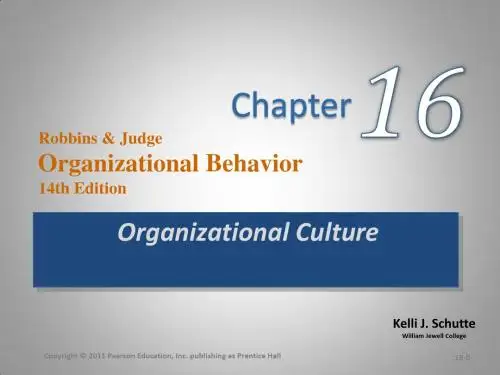
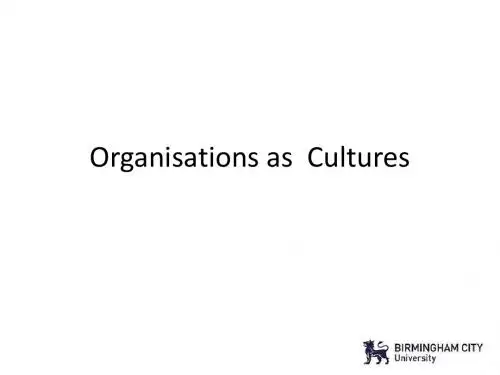
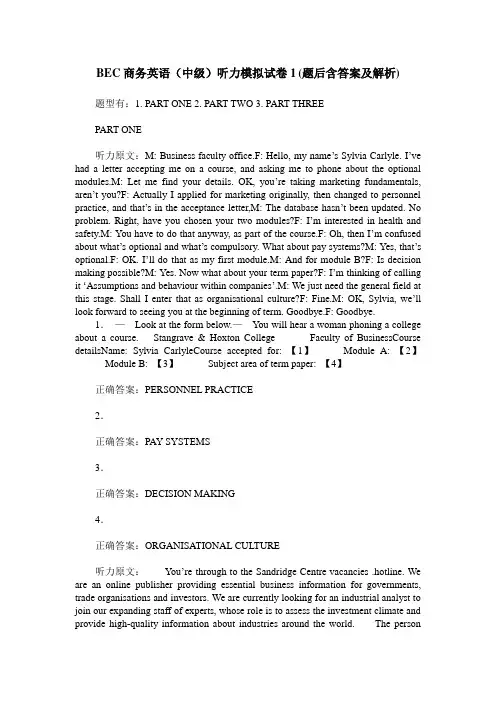
BEC商务英语(中级)听力模拟试卷1(题后含答案及解析)题型有:1. PART ONE 2. PART TWO 3. PART THREEPART ONE听力原文:M: Business faculty office.F: Hello, my name’s Sylvia Carlyle. I’ve had a letter accepting me on a course, and asking me to phone about the optional modules.M: Let me find your details. OK, you’re taking marketing fundamentals, aren’t you?F: Actually I applied for marketing originally, then changed to personnel practice, and that’s in the acceptance letter,M: The database hasn’t been updated. No problem. Right, have you chosen your two modules?F: I’m interested in health and safety.M: You have to do that anyway, as part of the course.F: Oh, then I’m confused about what’s optional and what’s compulsory. What about pay systems?M: Yes, that’s optional.F: OK. I’ll do that as my first module.M: And for module B?F: Is decision making possible?M: Yes. Now what about your term paper?F: I’m thinking of calling it ‘Assumptions and behaviour within companies’.M: We just need the general field at this stage. Shall I enter that as organisational culture?F: Fine.M: OK, Sylvia, we’ll look forward to seeing you at the beginning of term. Goodbye.F: Goodbye.1.—Look at the form below.—You will hear a woman phoning a college about a course. Stangrave & Hoxton College Faculty of BusinessCourse detailsName: Sylvia CarlyleCourse accepted for: 【1】______Module A: 【2】______Module B: 【3】______Subject area of term paper: 【4】______正确答案:PERSONNEL PRACTICE2.正确答案:PAY SYSTEMS3.正确答案:DECISION MAKING4.正确答案:ORGANISATIONAL CULTURE听力原文:You’re through to the Sandridge Centre vacancies .hotline. We are an online publisher providing essential business information for governments, trade organisations and investors. We are currently looking for an industrial analyst to join our expanding staff of experts, whose role is to assess the investment climate and provide high-quality information about industries around the world. The personappointed will join specialists in pensions and banking in our financial services team. As he or she will concentrate on insurance, considerable knowledge of this field is essential. Other industries that we cover include telecoms and healthcare. As our staff need to collect and analyse a great deal of data, only applicants with research experience will be considered. Shortlisted candidates will be asked to provide evidence of this. Preference will be given to candidates with regional expertise. This could be derived 1%m study or from working abroad. Applications, consisting of a CV and covering letter, should be sent to the Human Resources Manager before the end of this month. Thank you for phoning.5.—Look at the notes below.—You will hear a recorded message about a job vacancy. NotesVacancy at Sandridge Centre for 【5】______must know a lot about 【6】______must have carried out 【7】______【8】______ knowledge would be a plus正确答案:INDUSTRIAL ANALYST6.正确答案:INSURANCE7.正确答案:RESEARCH8.正确答案:REGIONAL听力原文:F: Workstations department.M: Hello. I’m calling from Crawford’s, the accountants. We’re looking for something to stand a computer on.F: Right. Are you interested in a PC table, which is designed to hold a computer, monitor and keyboard, and still give plenty of working space, or a more compact terminal table, without the working space?M: Oh, the smaller one will do. It’s for a computer that we don’t use much.F: OK Well, we have two versions: there’s height adjustable and standard.M: The first, I think as different people will be using it.F: And are you interested in a mouse shelf or side extensions, both of which come extra?M: I don’t think so. Oh, perhaps a mouse shelf. Will it fit on either side of the keyboard?F: Yes.M: Is there anywhere to put a printer?F: Well there’s nothing integral, but you can buy a printer stand, which is separate and l~tS underneath the table.M: OK, I’ll probably do that, I’ll come in and have a look at the equipment.F: Fine. We’re open until...9.—Look at the form below.—You will hear a man enquiring about computer workstations. Moorfield’s Department Stores Workstations department Enquiry formCustomer: crawford’sItem: 【9】______Model: 【10】______Extra(s): 【11】______Notes: Also interested in a 【12】______ 正确答案:TERMINALTABLE10.正确答案:HEIGHTADJUSTABLE11.正确答案:MOUSE SHELF12.正确答案:PRINTER STANDPART TWO听力原文:Growth for a new business like ours can be as much of a problem as a positive. You’re struggling to keep up on all fronts, and the people side of things can be a real headache. What we do is rather specialised, which means you can’t just take people on as and when you need them. That’s why making the skills building sessions available to more people was a good idea, as it means we can grow expertise internally.13.—You will hear five short recordings about improvements in the workplace.—For each recording, decide What improvement has been made.—Write one letter (A - H) next to the number of the recording.—Do not use any letter more than once.—You will hear the five recordings twice.A Some inefficient equipment was replaced.B A bonus payment system was extended.C A department was moved to new premises.D Training opportunities were increased.E A system of cost control was implemented.F Some software was upgraded.G A number of specialist staff were recruited.H A system of promotion was introduced.正确答案:D听力原文:Well, it is a step in the right direction, although there’s still a long way to go before we can really maximise out potential. But using the database had been difficult, because we were running it on such old PCs and they kept crashing. Now we’ve got high quality ones, it should all start to go more smoothly. Though of course training to work with them is still an issue.14.正确答案:A听力原文:Small businesses can be incredibly inefficient in all sorts of ways. We’ve certainly been guilty of paying out for things without checking the outlay against the benefits. But with this new chap appointed, I can see we’re going to be much more careful. We have to put everything to him, and he analyses all spending. Waste is going right down, and we’ve cancelled some orders for unnecessary new machinery. Margins are looking better already.15.正确答案:E听力原文:If we want to stick to our plan for growth, then we have to make sure that we retain staff. We certainly can’t afford to keep taking on new people and training them up. I think we were right to drop the purely financial rewards for meeting targets - people are as interested in long-term security as in cash. But the prospect of moving up to the new team leader level seems to be a stronger incentive - a good decision.16.正确答案:H听力原文:It was very complicated to arrange, but now we’re seeing the benefits. There just wasn’t enough room for everyone and everything. People had to keep going downstairs to do copying, and they could hear each other’s phone calls - very distracting. But setting admin up in the new building has given everyone room to breathe, and the atmosphere in both places is better now. The next thing will be upgrading the PCs.17.正确答案:C听力原文:Well, obviously every team’s going to be different, but some things should be standard practice. For the thing to hold together, everyone’s got to be pulling their weight, whatever their role is, so you need to keep a keen eye on how they’re all doing. Keep tabs on whether they’ve done what they should have, and whether they’re getting things done on time. You need to be equal and fair with everyone.18.—You will hear another five recordings.—You will hear five speakers talking about running project teams.—For each recording, decide what the speaker recommends.—Write one letter (A - H) next to the number of the recording.—Do not use any letter more than once.—You will hear the five recordings twice.A Publish regular updates on progress.B Provide specific training for participants.C Define individual roles clearly.D Recruit members from different departments.E Check targets and deadlines frequently.F Obtain input from external experts.G Examine the achievements of previous teams.H Allocate sufficient technologicalresources.正确答案:E听力原文:If you’re putting people together for a particular purpose on top of their normal work you need to be sure they’ve got everything they need to fulfill their brief, Communication is a key factor, so be sure they have the tools to achieve quality. on that front - a laptop for , meetings, a bulletin board on the intranet and so on. Special teams need high visibility to keep their motivation up, and to maintain interest among other staff.19.正确答案:H听力原文:There’s no point re inventing the wheel for every team. You can look outside the current group for ideas. See what teams in other departments or divisions have managed to do - you’ll often find they’ve worked in similar circumstances, and you can look at how they handled it. That’ll give you ideas of what to do - and, often, what not to do, too. It should mean your own progress is smoother.20.正确答案:G听力原文:The trouble is that when things seem to go wrong, it may be too late to fix them, because you actually built the problem in from the start. It’s vital that each member of the team knows exactly what it is he or she is supposed to contribute. You won’t get a good whole if the parts aren’t put together properly. If members are from different departments, they’ll have different expectations, which need to be dealt with.21.正确答案:C听力原文:A team can look like a single unit from the outside, but be chaos within, with nobody really understanding what’s going on. Or, as often happens, they have conflicting ideas of what they’re trying to achieve. It can help to avoid such problems if you build in an education phase at the start - make sure everyone is fully inducted by teaching them the skills they’ll need for the project. It’ll make life easier - or bearable, at least.22.正确答案:BPART THREE听力原文:M: Sally, everyone’s talking about the changes. I’d be interested to know what you make of them.F: Well, Louis, I think it’s a mixed bag. I guess they’ve been fairly carefully planned. I think every department head was consulted, so ideas were contributed from the whole organisation. The chairman put a lot of thought into bringing it all together, which is probably due to his background in consultancy - wanting to get the whole picture clear, before finally deciding.M: I hadn’t realised they’d been so long in the making - they seemed to come out of the blue,F: Oh no, it’s been building up. The idea is to give our whole operation a boost. We’ve been paying the price for low motivation for quite a while, and it’s time to turn staff retention rates around. Sales and profits have been static for too long, but if we can get more commitment out of people, things should pick up.M: Sounds reasonable. As I say, I thought they’d happened rather suddenly. If other senior staff are thinking that too, they’re going to feel some resentment. But then again, it doesn’t mean they won’t get on with implementing them, so I guess it’ll all end up alright.F: I hope you’re right. Still, I’m personally rather unconvinced about the new working hours.M: Oh?F: Well the idea sounds nice having core hours from I I to 3 and leaving people free to start as early or late as they want and finish accordingly ...M: And maybe working four long days and having longer weekends.F: But it’ll mean we’ll be very understaffed on some days, and then those people who are here will have to take everybody’s calls, so less actual work will get done that’s how I see it turning out in the end, anyway.M: I see what you mean. What other problems do you foresee?F: I think the sales targets could have been better thought out. I know the idea is to encourage a spirit of healthy competition, which is no bad thing of course, but they’ve been applied right across the board in the departments affected. People can’t be expected to achieve the same regardless of what they’re selling. It’s a fact that some models outsell others, and that ought to be reflected in the targets.M: Well, on a more positive note, I’m all in favour of the training that’s being introduced.F: Uh-huh.M: It’s going to be far more accessible. When we had sessions provided by the college, the topics were rather limited, it seemed to me, but now there’s a much wider range on offer, not just internet and database management all the time. I just hope they timetable it sensibly.F: Oh, I think they will, after all the effort of setting it up. Something I’m looking forward to is the newsletter- that’s a great idea.M: Yes, it makes you wonder why we haven’t had one before.F: It’ll be a real boost for corporate culture, make everyone feel involved. The overseas reps will particularly, appreciate it - they can feel outside the loop except when they’re over here, which is only twice a year I suppose most of the contributions will come from managers. People joining the company will probably assume we’ve always had it, but I’m sure it’ll be an improvement.M: So, some hope for the future?F: Let’s give it about six months to see how it all plays out. It takes time to tell whether things are going to succeed, and everyone will need to be consulted to get their views and experiences on the changes. The real test will be morale, and whether it seems to go up or down, but I’d guess these won’t be the last changes, and that we’ll see more major changes introduced.M: As you say, time will tell ...—You will hear two managers, Louis and Sally, discussing changes in theircompany.—For each question 23 - 30, mark one letter (A, B or C) for the correct answer.—You will hear the recording twice.23.Sally says that the changes were planned byA.a cross-departmental team.B.management consultants.C.the company chairman,正确答案:C24.She says the changes are designed to deal withA.high staff turnover.B.increased costs.C.falling sales.正确答案:A25.What does Louis feel about the changes?A.They should have happened soonerB.Some managers will dislike them.C.Their success will be limited.正确答案:B26.Sally says the new working hours will beA.less productive in the long run.B.unpopular with some staff.C.difficult to control.正确答案:A27.She thinks that the new sales targetsA.fail to consider competitors.B.are too high for her department.C.should vary according to the product.正确答案:C28.Louis thinks the new training will be effective becauseA.it is available on-line.B.it covers more topics.C.it uses outside trainers.正确答案:B29.Sally says that the newsletter will be most valuable for A.new staff.B.management.C.agents abroad.正确答案:C30.What does she think will happen in six months’ time? A.There will be new policies.B.Staff morale will be higher.C.Consultants will be hired.正确答案:A。
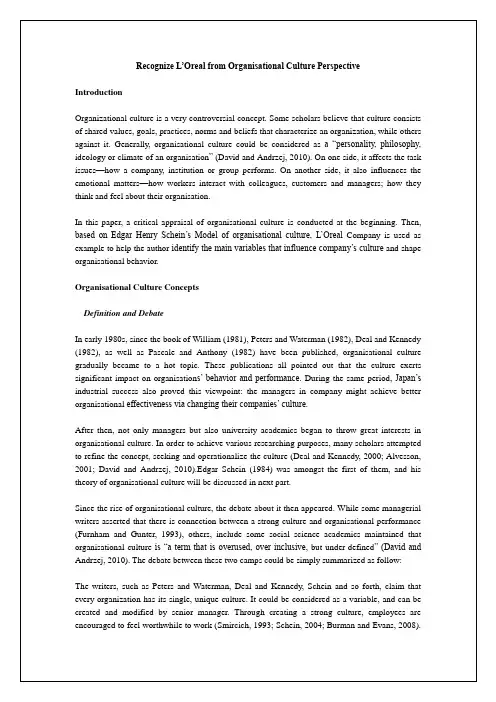
•Communal Culture (High sociability/High solidarity).Members think and act friendly to each others; Adhere to company’s value; High degree of cohesion.•Network Culture (High sociability/Low solidarity).Members act friendly but think different to each other; High competitive environment.•Mercenary Culture (Low Sociability/High solidarity).Members think alike but are not friendly to each others; High competitive environment.•Fragment Culture (Low sociability/Low solidarity): Members think and act differently and unfriendly; Depend on key individuals.Actually, one organisation often has different culture in different sections. For example, at L'Oréal cosmetic company, product researching department has task culture but marketing and accounting departments own role culture. And, these cultures are not fixed forever, they would change as company personal and strategy changed.Analysis Based o n Schein’s ModelEdgar Schein, an MIT Sloan School of Management professor, His model of culture now is widely accepted worldwide. According to Schein, culture has three cognitive levels (Figure 1). The first level is the surface manifestation of culture, also called ‘observable culture’. It included the most visible things (e.g. ceremonials, courses, heroes, language, legends, mottoes, norms, sagas, slogans, stories, symbols and others) produced by a culture. The second one is organisational values. These are accumulated beliefs about how do employees work and how their solve problems. Values can distinguish on organisation from another. The third level is basic assumption. Basic assumptions are invisible understandings held by members in an organisation, concerning “the nature of reality and the organisation’s relationship to its environment” (She in, 1997). It can be summarized in brief statements such as quality, morality, stability, responsibility and innovativeness.Figure 1: Schein’s Level of Culture (Schein, 2004)Based on Schein’s model, the author tries to analyse the organisational culture of L’Oreal Company. L’Oreal is the world’s largest cosmetics and beauty Group, and has more than 890 different companies around the world, selling hair care, skin care, make-up, perfumes and other beauty products in over 130 countries. Walking into an L’Oreal’s retail store, you will notice thatstaff here look confident and exude style feeling. Table 2 clearly shows the surface elements of culture at L’Oreal.Table 2. Example of Surface Manifestations of Culture at L’OrealManifestation L'Oréal as ExampleArtefacts Numbered golden name badges, formal work suit, stationery,Ceremonials Make up competition, Fun days, Annual partyCourses Service selling program for salesman, advanced management program for managers, makeup and image design course for beauty advisers, advancedtraining for research staffHeroes Eugene Schueller (the founder)Legends O’cap considered as the first hair conditioner, Elnett hair spray, Innéov isthe first oral beauty productMottoes Savoir saisir ce qui commence (seize new opportunities).Norms Ethics, respect, innovation, beautySagas In 1988, the research and development pioneer Charles Zviak, hands over the reins of the company to Lindsay Owen-Jones, a truly outstandingdirector, Who successful lead the Group to become the world leader incosmetics.Slogans You Deserve it!Stories After graduate from France’s national chemical engineering school in 1904, Eugène Schueller created his first hair dye formulae, using a blend ofharmless chemical compounds. These dyes produced a subtle range ofcolors, and easily won the market.Symbols L’Oreal brandSource: personal communication from employees and store managerAccording to one manager introduce, that in order to hold operations together and guide employees’ b ehavior,L'Oréal uses a strong organisational culture named ‘L'Ore al Spirit’ relies on following values:First, all employees at L’Oreal believe that everyone aspires to beauty. So help people around world relies this aspiration and express beauty is the G roup’s mission. Second, every employee is entitled to a safe and health working environment. There are many various kinds of potted plants in L’Oreal’s office, made people feel relax and mild. Moreover, the company encourages an atmosphere of openness, generosity, courage and respect, therefore all members here feel free to convey their ideas and opinions. The third value focus on respect: employees need respect for other people and their skill or special knowledge. The fourth value is about environment. Give avery small example: you can see a very special shutter which embedded into two pieces of glass in L’Oreal’s workplace. Two-pieces glass window could maintain the room temperature, and the designed shutter could change its angle automatically along with outdoor lights, which keep the room bright without lamp, in great extent save the energy. This small detail help L’Oreal install environment concern in employees’ day-to-day work.In addition, the Group generously offers opportunities for young staffs with great potential to put their abilities to full use. This talent cultivation consists of two specific ways: Career development and rewards (i.e. encourages mobility through transfer position promotions; rewards through pay rise, transfer promotion or internal promotion); Employee training and education (e.g. various training sessions in room; Bi-annual development interviews). Mr. Agon’s career development may be a best example here. In 1991, after two years he joined the Group, only 24-year-old talented Mr. Agon was appointed as general manager of company’s Greek branch. Then, the company provided him opportunities to try out various different innovations, including introducing new business policies. In the end, Mr. Agon brought his Greek Branch to success. Generally, compared to other company’s value, L’Oreal prefer to offer many opportunities for young employees to challenge themselves.The last but most important value is diversity. From various people who make up its team to the products developed, diversity has always been a priority for the company. This diversity includes several aspects: diversity of origins, encourage gender equality, encourage employment of the people with disabilities and so the forth. For example, in order to guarantee diversity in function, L’Oreal, for many years, kept hiring almost same number of female and male employees, and giving equal treatment in terms of salary and training to them(Chart 3). For another instance, when company recruits, there are no much more specific requirements about what an employee should like. The company only pays much attention on candidates’ personality, such as leadership, innovation capability and enthusiasm, rather than gender, educational background or study major.Chart 3. Gender equality indicator at L’OrealSource:L’Oreal diversity reportConclusionAbove all, the author considered L’Oreal as an appreciated with a ‘mild, tolerate and fashionable’ culture. ‘Be m ild’because company made employees feel free to share their own idea and complain; ‘Be tolerate’ because company promoted diversity in almost aspects; ‘Be fashionable’。
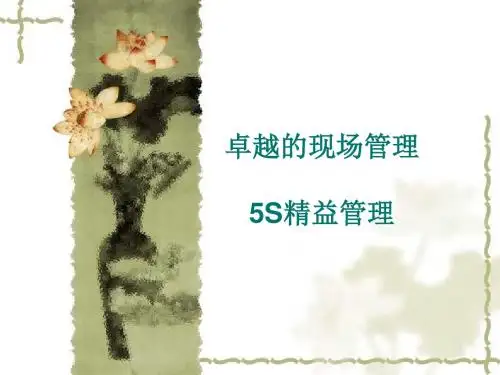
组织文化量表(Organizational Culture Assessment Instrument,简称OCAI),Cameron和Quinn(1998)提出的组织文化量表是以竞值架构理论为基础( Competing Values Framework,简称CVF),而组织文化的好坏更会进一步的影响组织的效能,其与决策的制定及人资管理更是密不可分的。
Cameron和Quinn将组织文化分为四种类型,包含:团队文化类型、灵活文化类型、市场文化类型和层级文化类型,量表分为六个维度,分别为主导特征、领导风格、员工管理、组织凝聚、战略重点和成功标准,总共为24个条目。
量表的计分方式将受试者感受、反应及认同程度为评定指标,采用五点量表级分方法。
其标准为“1”表示非常不符合;“2”表示不符合;“3”表示普通;“4”表示符合;“5”表示非常符合。
量表的条目一、主导特征1. 我的组织是一个人性化的组织,像一个大家庭,成员间能分享彼此的经验或想法①非常不符合②不符合③普通④符合⑤非常符合2. 我的组织是一个具有活力和创业精神的组织,成员富有进取心与冒险精神①非常不符合②不符合③普通④符合⑤非常符合3. 我的组织是成果导向型组织,强调工作的完成,成员具有强烈的竞争意识与成就导向①非常不符合②不符合③普通④符合⑤非常符合4. 我的组织是一个严格管理与层级分明的组织,成员严格按规章制度做事①非常不符合②不符合③普通④符合⑤非常符合二、领导风格5. 我的组织的最高管理者能主动指导、协助并关爱组织成员①非常不符合②不符合③普通④符合⑤非常符合6. 我的组织的最高管理者具有企业家精神,注重创新并勇于冒险①非常不符合②不符合③普通④符合⑤非常符合7. 我的组织的最高管理者行事严谨,富有进取心并重视成果①非常不符合②不符合③普通④符合⑤非常符合8. 我的组织的最高管理者擅于协调与组织,注重组织的顺畅运作①非常不符合②不符合③普通④符合⑤非常符合三、员工管理9. 我的组织重视团队合作、协商及成员的参与①非常不符合②不符合③普通④符合⑤非常符合10. 我的组织重视个人的冒险,强调创新、自由及展现自我①非常不符合②不符合③普通④符合⑤非常符合11. 我的组织强调竞争,强调高要求,注重竞争目标的达成①非常不符合②不符合③普通④符合⑤非常符合12. 我的组织重视成员工作的保障及稳定性,员工之间的关系是可预见及稳定的①非常不符合②不符合③普通④符合⑤非常符合四、组织凝聚13. 促使我的组织凝聚的力量是成员的忠诚及相互信任,强调对组织的承诺①非常不符合②不符合③普通④符合⑤非常符合14. 促使我的组织凝聚的力量是对创新与发展的承诺,强调走在时代的前沿①非常不符合②不符合③普通④符合⑤非常符合15. 促使我的组织凝聚的力量是对成就与目标达成的重视①非常不符合②不符合③普通④符合⑤非常符合16. 促使我的组织凝聚的力量是正式的规章制度,强调组织运作的顺畅①非常不符合②不符合③普通④符合⑤非常符合五、战略重点17. 我的组织重视人力资源的发展,强调高度信任、开诚布公及员工的持续参与①非常不符合②不符合③普通④符合⑤非常符合18. 我的组织重视获取新资源及迎接新挑战,强调尝试新事物和寻求新机遇①非常不符合②不符合③普通④符合⑤非常符合19. 我的组织重视竞争与成功,强调达成更多目标以及在市场中获胜①非常不符合②不符合③普通④符合⑤非常符合20. 我的组织重视持久与稳定,强调效率、控制及顺畅的运作①非常不符合②不符合③普通④符合⑤非常符合六、成功标准21. 我的组织对成功的界定是在人力资源、团队合作、员工承诺及关心员工方面得以发展①非常不符合②不符合③普通④符合⑤非常符合22. 我的组织对成功的界定是组织有独特、新颖的产品,是产品的领导者和创新者①非常不符合②不符合③普通④符合⑤非常符合23. 我的组织对成功的界定是赢得市场份额并且打败对手,成为市场的领导者①非常不符合②不符合③普通④符合⑤非常符合24. 我的组织对成功的界定是富有效率。
organizational culture and its functions阅读理解Organizational culture refers to the shared values, beliefs, customs, practices, and behaviors that exist within an organization. It represents the unique personality of the organization and sets the tone for how things are done.The functions of organizational culture include:1. Identity and Sense of Belonging: Organizational culture helps create a sense of identity, belonging, and purpose among employees. When employees feel connected to the organization, they are more likely to be engaged and committed to their work.2. Norms and Expectations: Culture establishes norms and expectations for behavior within the organization. It sets guidelines for how employees should interact with each other, handle conflicts, make decisions, and accomplish tasks.3. Communication and Collaboration: Culture influences communication patterns and collaboration within the organization. It determines how information is shared, whether there is open and transparent communication, and how teams work together to achieve common goals.4. Decision-making and Problem-solving: Culture shapes decision-making and problem-solving processes. It can influence whether decisions are made collectively or by top management, how risks are approached, and how conflicts are resolved.5. Performance and Productivity: Culture affects performance andproductivity within the organization. A positive culture that values teamwork, innovation, and continuous improvement can enhance employee motivation and job satisfaction, leading to higher levels of productivity.6. Attraction and Retention of Talent: Organizational culture playsa significant role in attracting and retaining talented employees. A strong culture that aligns with individuals' values and aspirations can attract like-minded individuals who are more likely to stay with the organization in the long term.7. Change and Adaptation: Culture can either facilitate or hinder organizational change and adaptation. A flexible and adaptive culture can help organizations navigate and embrace change, while a rigid and resistant culture can impede progress.In summary, organizational culture shapes the collective mindset, behaviors, and practices within an organization, impacting various aspects of employee engagement, communication, decision-making, performance, and adaptability.。